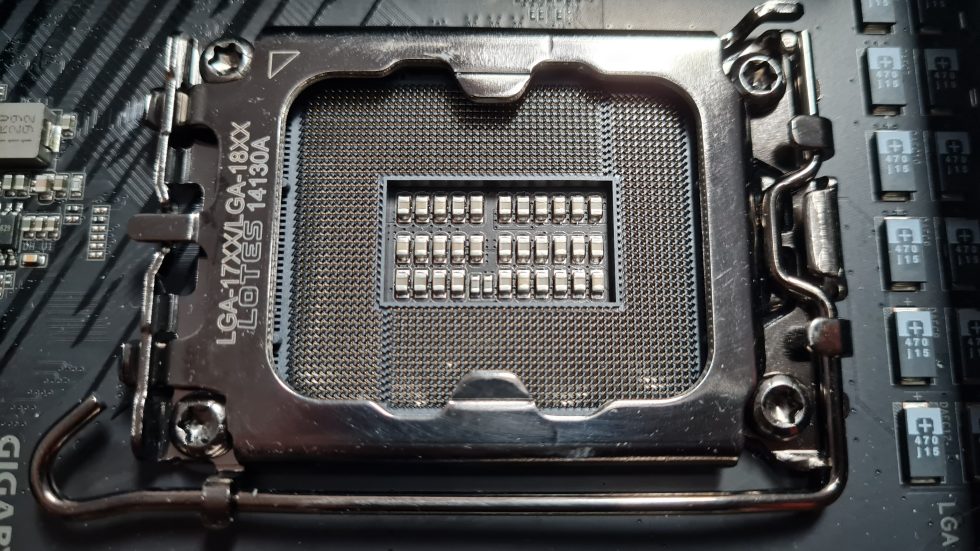As promised, today we cover part 2 of the “Washermod”, in which we want to evaluate a few more combinations of different motherboards, socket manufacturers and coolers in a before and after test with the modification. To briefly summarize what the washer mod is all about: washers are installed between the motherboard and the ILM (Independent Loading Mechanism) of the LGA1700 socket so that less pressure is exerted on the CPU, which in turn results in a more flat surface and thus better contact with the cooler. Details on theory, implementation and measurement methodology are given in the first part.
LGA1700 manufacturer – Lotes vs. Foxconn


In the first part, my guinea pig was a Gigabyte Aorus Z690 Tachyon that uses a socket from Lotes. The question naturally arises whether different base brands could bend differently and thus perhaps produce different results. So here’s the MSI Z690 Unify-X, which uses an LGA1700 socket from Foxconn. Only the manufacturers Foxconn and Lotes are currently available for LGA1700. So with this again I tested all the different thicknesses of washers, since this could have an effect on the bending of possibly softer materials.
MSI MEG Z690 Unify-X (Foxconn), 12900K 51/0/49, 1.35 Vcore LLC7, Corsair XC7 PRO RGB LGA1700:
| Washer Config | P0 max Δ | P1 max Δ | P2 max Δ | P3 max Δ | P4 max Δ | P5 max Δ | P6 max Δ | P7 max Δ | Ø | relative |
| stock | 59.9 | 67.9 | 62.0 | 72.7 | 64.1 | 68.7 | 62.3 | 62.0 | 64.95 | — |
| 0.5 mm | 59.9 | 66.9 | 61.7 | 72.0 | 63.8 | 66.2 | 61.9 | 61.1 | 64.19 | -0.76 |
| 0.8 mm | 57.2 | 63.5 | 61.4 | 69.9 | 63.2 | 66.1 | 60.2 | 61.1 | 62.83 | -2.13 |
| 1.0 mm | 55.0 | 61.6 | 58.0 | 67.0 | 58.4 | 62.6 | 57.7 | 56.9 | 59.65 | -5.30 |
| 1.3 mm | 57.2 | 64.0 | 61.9 | 68.1 | 63.1 | 63.9 | 61.9 | 58.1 | 62.28 | -2.68 |
In short, here too we end up with around 5 °C improvement with 1.0 mm thick washers compared to the factory version of the socket. After all, the socket manufacturers seem to adhere to Intel’s specification in a very similar way. How useful this is (not), is up for debate. I also once tested plastic vs. steel washers of the same thickness, and again the difference is within the range of measurement tolerance. While I do record the water temperature to within 0.1 °C, only integer values can be returned for the core temperatures, which of course affects the accuracy of the measurements. By the way, on the Unify-X with 1.3 mm washers was the only config with detectable impact on RAM stability in my tests. Though the board performed a new memory training on its own during the first boot, after which the RAM was immediately stable again.
With E-Cores – more efficiency (waste heat)
Since 1.0 mm could be identified as the ideal dimension for the washers for both socket makes – at least according to our measurements – all further tests will only be carried out with this dimension, also to save some time. But on the flipside I also grabbed the Asus Maximus Z690 Apex and the ASRock Z690 PG Riptide and simply tested the CPU with default settings. So PL1 4095W, E-cores active and all clock speeds and voltages on auto, because if we’re honest, a majority of CPUs will run in this state for their entire lives.
Asus Maximus Z690 Apex (Lotes), 12900K, Auto, Corsair XC7 PRO RGB LGA1700:
| Washer Config | P0 max Δ | P1 max Δ | P2 max Δ | P3 max Δ | P4 max Δ | P5 max Δ | P6 max Δ | P7 max Δ | E0-3 max Δ | E4-7 max Δ | Ø | rel. |
| stock | 53.7 | 61.5 | 58.5 | 64.5 | 60.5 | 61.5 | 56.5 | 56.8 | 45.5 | 44.5 | 56.35 | — |
| 1.0 mm | 48.8 | 56.4 | 53.7 | 59.4 | 54.7 | 58.3 | 53.3 | 55.4 | 43.3 | 40.8 | 52.41 | -3.94 |
The difference between the stock and 1.00 mm configs has now shrunk to about 4 °C, but that also fits in with the fact that the heat is now distributed over a larger area in the CPU. The e-cores are each grouped in clusters of 4 cores and only have one temperature sensor together. But they also benefit measurably and reproducibly from the Washermod.
ASRock Z690 PG Riptide (Foxconn), 12900K, auto, Corsair XC7 PRO RGB LGA1700:
| Washer Config | P0 max Δ | P1 max Δ | P2 max Δ | P3 max Δ | P4 max Δ | P5 max Δ | P6 max Δ | P7 max Δ | E0-3 max Δ | E4-7 max Δ | Ø | rel. |
| stock | 57.9 | 63.5 | 61.5 | 69.5 | 64.5 | 68.5 | 60.9 | 65.4 | 49.5 | 50.5 | 61.17 | — |
| 1.0 mm | 53.2 | 58.4 | 56.8 | 61.1 | 57.0 | 60.9 | 55.4 | 57.2 | 44.4 | 44.3 | 54.87 | -6.3 |
On the Z690 PG Riptide, the gap has increased to almost 6 °C again, whereby this board automatically applies a slightly higher core voltage and thus produces more waste heat, and the measurement tolerance is also a factor. So here the picture of about 4-6 °C improvement by the mod is confirmed as well.
































31 Antworten
Kommentar
Lade neue Kommentare
Mitglied
Urgestein
Veteran
Veteran
Mitglied
Urgestein
Mitglied
Neuling
Veteran
Mitglied
Urgestein
Veteran
Mitglied
Veteran
Mitglied
Veteran
Neuling
Veteran
Mitglied
Alle Kommentare lesen unter igor´sLAB Community →